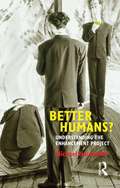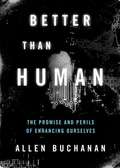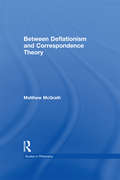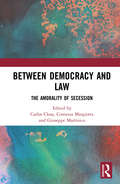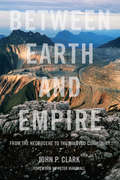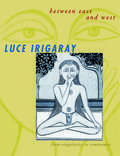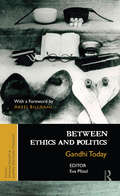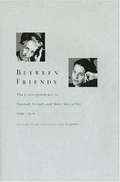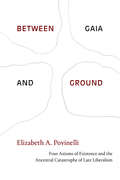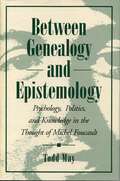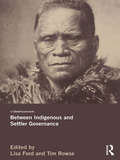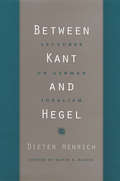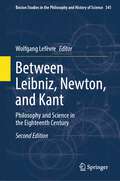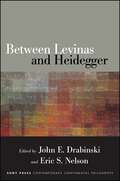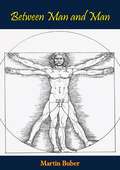- Table View
- List View
Better Humans?: Understanding the Enhancement Project
by Michael HauskellerDevelopments in medical science have afforded us the opportunity to improve and enhance the human species in ways unthinkable to previous generations. Whether it's making changes to mitochondrial DNA in a human egg, being prescribed Prozac, or having a facelift, our desire to live longer, feel better and look good has presented philosophers, medical practitioners and policy-makers with considerable ethical challenges. But what exactly constitutes human improvement? What do we mean when we talk of making "better" humans? In this book Michael Hauskeller explores these questions and the ideas of human good that underpin them. Posing some challenging questions about the nature of human enhancement, he interrogates the logic behind its processes and examines the justifications behind its criteria. Questioning common assumptions about what constitutes human improvement, Hauskeller asks whether the criteria proposed by its advocates are convincing. The book draws on recent research as well as popular representations of human enhancement from advertising to the internet, and provides a non-technical and accessible survey of the issues for readers and students interested in the ethics and politics of human enhancement.
Better Living Through Criticism
by A. O. ScottThe New York Times film critic shows why we need criticism now more than everFew could explain, let alone seek out, a career in criticism. Yet what A.O. Scott shows in Better Living Through Criticism is that we are, in fact, all critics: because critical thinking informs almost every aspect of artistic creation, of civil action, of interpersonal life. With penetrating insight and warm humor, Scott shows that while individual critics--himself included--can make mistakes and find flaws where they shouldn't, criticism as a discipline is one of the noblest, most creative, and urgent activities of modern existence.Using his own film criticism as a starting point--everything from his infamous dismissal of the international blockbuster The Avengers to his intense affection for Pixar's animinated Ratatouille--Scott expands outward, easily guiding readers through the complexities of Rilke and Shelley, the origins of Chuck Berry and the Rolling Stones, the power of Marina Abramovich and 'Ode on a Grecian Urn.' Drawing on the long tradition of criticism from Aristotle to Susan Sontag, Scott shows that real criticism was and always will be the breath of fresh air that allows true creativity to thrive. "The time for criticism is always now," Scott explains, "because the imperative to think clearly, to insist on the necessary balance of reason and passion, never goes away."From the Hardcover edition.
Better Than Human: The Promise and Perils of Enhancing Ourselves
by Allen BuchananIS IT RIGHT TO USE BIOMEDICAL TECHNOLOGIES TO MAKE US BETTER THAN WELL OR EVEN PERHAPS BETTER THAN HUMAN? Should we view our biology as fixed or should we try to improve on it? College students are already taking cognitive enhancement drugs. The U.S. Army is already working to develop drugs and technologies to produce "super soldiers." Scientists already know how to use genetic engineering techniques to enhance the strength and memories of mice, and the application of such technologies to humans is on the horizon. In Better Than Human, philosopher-bioethicist Allen Buchanan grapples with the ethical dilemmas of the biomedical enhancement revolution. Biomedical enhancements can make us smarter, have better memories, be stronger, quicker, have more stamina, live much longer, avoid the frailties of aging, and enjoy richer emotional lives. In spite of the benefits that biomedical enhancements may bring, many people instinctively reject them. Some worry that we will lose something important--our appreciation for what we have or what makes human beings distinctively valuable. Others assume that biomedical enhancements will only be available to the rich, with the result that social inequalities will worsen. Buchanan shows that the debate over enhancement has been distorted by false assumptions and misleading rhetoric. To think clearly about enhancement, we have to acknowledge that human nature is a mixed bag and that our species has many "design flaws." We should be open to the possibility of becoming better than human, while never underestimating the risk that our attempts to improve may backfire.
Between Care and Justice: The Passions as Social Resource (SUNY series in Contemporary Italian Philosophy)
by Elena PulciniElena Pulcini (1950–2021), an internationally renowned philosopher of care, was at the forefront of thinking and creating a new ethical framework to respond efficaciously to problems that affect individuals at a global level. This translation of Pulcini's last work addresses perhaps the two fundamental questions for our times—namely, "Why care for others when we are not bound by personal relationships?" and "Why commit to justice even when it does not personally affect us?" By focusing on passions such as indignation, fear, compassion, resentment, and love, Pulcini offers an alternative ethical perspective in which justice and care intertwine to supplement and balance each other. Together, care and justice are proven capable of addressing the challenge of the "other," distant in space (the outsider, the marginalized, and the migrant) and time (future generations). In the end, Pulcini proposes a form of moral education that nurtures and develops desirable moral sentiments for a more just world at the interpersonal, social, political, economic, and environmental levels, thereby providing an alternative social, global model to current individual-focused, rights-based, purely rationalist ethical systems.
Between Celan and Heidegger (SUNY series, Literature . . . in Theory)
by Pablo OyarzunThe relevance of Martin Heidegger’s thinking to Paul Celan’s poetry is well known. Between Celan and Heidegger proposes that, while the relation between them is undeniable, it is also marked by irreducible discord. Pablo Oyarzun begins with a deconstruction of Celan’s Todtnauberg, written after the poet visited Heidegger in his Schwarzwald cabin. The poem stands as a milestone, not only in the complex relationship between the two men but also in the state of poetry and philosophy in late modernity, in the aftermath of the Holocaust. Discussion then turns to The Meridian, Celan’s acceptance speech for the prestigious Büchner Prize for German language literature. Other issues are insistently addressed—place, art, language, pain, existence, and the Heideggerian notion of dialogue—as Oyarzun revisits several essential poems from Celan’s oeuvre. A rare translation of Oyarzun’s work into English, Between Celan and Heidegger affirms the uniqueness of Celan’s poetry in confrontation both with Heidegger’s discourse on Dichtung (a poetic saying centered in the idea of gathering) and with Western philosophical notions of art, technē, mimesis, poiesis, language, and thinking more broadly.
Between Deflationism and Correspondence Theory
by Matthew McGrathMcGrath argues for an original truth theory that combines elements of two well-known philosophical theories--deflationism and correspondence.
Between Democracy and Law: The Amorality of Secession
by Carlos Closa Giuseppe Martinico Costanza MargiottaThis volume purports to explore the legal and political issues triggered by the new wave of secessionism. More specifically, those issues concern the interplay between notions of democracy (and democratic ends and means) and law (and the rule of law and constitutionalism). Against this background, the editors use amorality in order to escape the terrain of the justification of secession by making a distinction between the democratic theory of secession and the theory of democratic secession. In the first section, the theoretical nexus democracy-secession has been approached both from a legal and political theory perspective. The second section of the book examines the instruments that the theory of democratic secession invokes in order to justify secession and presents both legal and political science contributions. The third section focuses on social movements and political actors. The fourth section focuses on two case studies due to the awareness of the importance of the difference between secession in a democratic occidental context (which call into play the discussion of the democratic theories) and separations in a non-democratic context (where the nexus between secession and democracy is not really central).
Between Deontology and Justice: Chinese and Western Perspectives (Routledge Studies in Contemporary Chinese Philosophy)
by Genyou WuIn China, political philosophy is still a comparatively new academic discipline. While there is no such phrase as “political philosophy” in ancient Chinese texts, there are elements within them that could be considered part of that field. Central questions of Chinese ancient political philosophy include the legitimacy of the source of political power, the foundation of moral rationality for the use of political power, and the purpose of political activities. This book explores the ideas of rights, the foundations of law, transference of power, democracy and other topics as debated in ancient times. Focusing on important political thinkers in Chinese history, such as Kongzi, Laozi, Xu Fuguan, Liang Qichao, and Li Dazhao, the book explains characteristics that are particular to China, such as the system of abdication, the general will of the people, and the society of Great Harmony. While making comparisons between Chinese and Western political philosophy, the book also discusses how to establish a Chinese modern state and how to promote Chinese culture today so that it can influence more and more people around the world. The book will be a valuable reference for scholars of Chinese philosophy, political philosophy, and Chinese culture.
Between Earth and Empire: From the Necrocene to the Beloved Community
by John P. ClarkBetween Earth and Empire focuses on the crucial position of humanity at the present moment in Earth History. We have left the Cenozoic, the "new period of life," and are now in the midst of the Necrocene, a period of mass extinction and reversal of the course of evolution of life on Earth. It is argued that an effective response to global crisis requires attention to all major spheres of social determination, including the social institutional structure, the social ideology, the social imaginary, and the social ethos. In this wide-ranging and ruthlessly compassionate critique, John P. Clark explores examples of significant progress in this direction, including the Zapatista movement in Chiapas, the Democratic Autonomy Movement in Rojava, indigenous movements in defense of the commons, the solidarity economy movement, and efforts to create liberated base communities and affinity groups within anarchism and other radical social movements. In the end, the book presents a vision of hope for social and ecological regeneration through the rebirth of a libertarian and communitarian social imaginary, and the flourishing of a free cooperative community globally.
Between East and West: From Singularity to Community
by Luce Irigaray Stephen PluhácekWith this book we see a philosopher well steeped in the Western tradition thinking through ancient Eastern disciplines, meditating on what it means to learn to breathe, and urging us all at the dawn of a new century to rediscover indigenous Asian cultures. Yogic tradition, according to Irigaray, can provide an invaluable means for restoring the vital link between the present and eternity -- and for re-envisioning the patriarchal traditions of the West. Western, logocentric rationality tends to abstract the teachings of yoga from its everyday practice -- most importantly, from the cultivation of breath. Lacking actual, personal experience with yoga or other Eastern spiritual practices, the Western philosophers who have tried to address Hindu and Buddhist teachings -- particularly Schopenhauer -- have frequently gone astray. Not so, Luce Irigaray. Incorporating her personal experience with yoga into her provocative philosophical thinking on sexual difference, Irigaray proposes a new way of understanding individuation and community in the contemporary world. She looks toward the indigenous, pre-Aryan cultures of India -- which, she argues, have maintained an essentially creative ethic of sexual difference predicated on a respect for life, nature, and the feminine. Irigaray's focus on breath in this book is a natural outgrowth of the attention that she has given in previous books to the elements -- air, water, and fire. By returning to fundamental human experiences -- breathing and the fact of sexual difference -- she finds a way out of the endless sociologizing abstractions of much contemporary thought to rethink questions of race, ethnicity, and globalization.
Between East and West: From Singularity to Community (European Perspectives: A Series in Social Thought and Cultural Criticism)
by Luce IrigarayWith this book we see a philosopher well steeped in the Western tradition thinking through ancient Eastern disciplines, meditating on what it means to learn to breathe, and urging us all at the dawn of a new century to rediscover indigenous Asian cultures. Yogic tradition, according to Irigaray, can provide an invaluable means for restoring the vital link between the present and eternity—and for re-envisioning the patriarchal traditions of the West. Western, logocentric rationality tends to abstract the teachings of yoga from its everyday practice—most importantly, from the cultivation of breath. Lacking actual, personal experience with yoga or other Eastern spiritual practices, the Western philosophers who have tried to address Hindu and Buddhist teachings—particularly Schopenhauer—have frequently gone astray. Not so, Luce Irigaray. Incorporating her personal experience with yoga into her provocative philosophical thinking on sexual difference, Irigaray proposes a new way of understanding individuation and community in the contemporary world. She looks toward the indigenous, pre-Aryan cultures of India—which, she argues, have maintained an essentially creative ethic of sexual difference predicated on a respect for life, nature, and the feminine. Irigaray's focus on breath in this book is a natural outgrowth of the attention that she has given in previous books to the elements—air, water, and fire. By returning to fundamental human experiences—breathing and the fact of sexual difference—she finds a way out of the endless sociologizing abstractions of much contemporary thought to rethink questions of race, ethnicity, and globalization.
Between Ethics and Politics: New Essays on Gandhi (Ethics, Human Rights and Global Political Thought)
by Eva PföstlIs it possible to build an authentically democratic system in politics without concrete ethical foundations? Addressing this question in the wake of the contemporary crisis in democracy worldwide, the volume re-evaluates Mohandas Karamchand Gandhi’s key thoughts. It foregrounds their relevance to the ongoing struggles that attempt to reconcile the apparently dissimilar orientations of politics and ethics. Collecting fresh interdisciplinary researches, the book provides insights into Gandhi’s complex — and occasionally turbulent — intellectual and political relationships with influential figures of Indian society and politics, whether critics such as B. R. Ambedkar and friends like Rabindranath Tagore and Jawaharlal Nehru. It also presents an informed political biography of Gandhi, encapsulating the salient details of his long trajectory as a unique mass mobilizer, socio-political activist and ideologue — from his days in South Africa to his death in independent India. This book will immensely interest scholars and students of political theory, philosophy, ethics, history, and Gandhian studies.
Between Faith and Belief: Toward a Contemporary Phenomenology of Religious Life (SUNY series in Theology and Continental Thought)
by Joeri SchrijversWhat is to be done at the end of metaphysics? Joeri Schrijvers's contemporary philosophy of religion takes up this question, originally posed by Reiner Schürmann and central to continental philosophy. The book navigates the work of thinkers who have addressed such metaphysical concerns, including Martin Heidegger, Emmanuel Levinas, Jean-Luc Nancy, Jean-Luc Marion, Peter Sloterdijk, Ludwig Binswanger, Jacques Derrida, and more recently John D. Caputo, Mary-Jane Rubenstein, and Martin Hägglund. Notably, Schrijvers engages both those who would deconstruct Christianity and those who remain within this tradition, offering an option that is "between:" between Christianity and atheism, between progressive and conservative, between faith and belief. Ultimately, Schrijvers confronts the end of metaphysics with a phenomenology of love and community, arguing for the radical primacy of togetherness.
Between Feminism and Materialism
by Gillian HowieIn her latest book, Gillian Howie offers a bold new way to make sense of the relationship between feminist theory and capitalism. This exciting combination of existentialism, phenomenology, and critical theory delivers a proactive feminism ready to respond to the challenges presented by our thoroughly modern times.
Between Friends: The Correspondence of Hannah Arendt and Mary McCarthy 1949-1975
by Hannah Arendt Mary Mccarthy Carol Brightman"They first met in New York: Mary McCarthy, an American writer, and Hannah Arendt, a philosopher who had fled Nazi Germany. They soon became friends and began a remarkable twenty-five-year exchange. McCarthy was an ardent, if not irrepressible, correspondent, whose letters served her autobiographical impulse and her delight in writing as a way of ordering experience. Arendt's letters bring her gruff, tender voice and keen intelligence to life on the page. Even as they traded ideas about politics, literature, morality, they also shared personal advice and delightful gossip." "Between Friends, edited and with an introduction by Carol Brightman, brings together their remarkable epistolary dialogue in its entirety. Engrossing and entertaining, it gives us a fresh and intimate view of the long and unique friendship between two eminent intellectual presences of the twentieth century." --BOOK JACKET. Title Summary field provided by Blackwell North America, Inc. All Rights Reserved
Between Gaia and Ground: Four Axioms of Existence and the Ancestral Catastrophe of Late Liberalism
by Elizabeth A. PovinelliIn Between Gaia and Ground Elizabeth A. Povinelli theorizes the climatic, environmental, viral, and social catastrophe present as an ancestral catastrophe through which that Indigenous and colonized peoples have been suffering for centuries. In this way, the violence and philosophies the West relies on now threaten the West itself. Engaging with the work of Glissant, Deleuze and Guattari, Césaire, and Arendt, Povinelli highlights four axioms of existence—the entanglement of existence, the unequal distribution of power, the collapse of the event as essential to political thought, and the legacies of racial and colonial histories. She traces these axioms' inspiration in anticolonial struggles against the dispossession and extraction that have ruined the lived conditions for many on the planet. By examining the dynamic and unfolding forms of late liberal violence, Povinelli attends to a vital set of questions about changing environmental conditions, the legacies of violence, and the limits of inherited Western social theory. Between Gaia and Ground also includes a glossary of the keywords and concepts that Povinelli has developed throughout her work.
Between Genealogy and Epistemology: Psychology, Politics, and Knowledge in the Thought of Michel Foucault
by Todd MayMichel Foucault introduced a new form of political thinking and discourse. Rather than seeking to understand the grand unities of state, economy, or exploitation, he tried to discover the micropolitical workings of everyday life that have often founded the greater unities. He was particularly concerned with how we understand ourselves psychologically, and thus with how psychological knowledge developed and came to be accepted as true. In the course of his writings, he developed a genealogy of psychology, an account of psychology as a historically developed practice of power.The problem such an account raises for much of traditional philosophy is that Foucault's critique of psychological concepts is ultimately a critique of the idea of the mind as a politically neutral ontological concept. As such, it renders politically suspect all forms of subjective foundationalism, and the epistemological justification for Foucault's own writings is then called into question. Drawing on the writings of such Anglo-American philosophers as Wilfrid Sellars and Ludwig Wittgenstein, Todd May refutes the idea that Foucault's critiques of knowledge, and especially psychological knowledge, undermine themselves.
Between Give and Take: A Clinical Guide to Contextual Therapy
by Ivan Krasner Boszormenyi-NagyIn this volume, Boszormenyi-Nagy and Krasner provide a comprehensive, sharply focused guide to the clinical use of Contextual Therapy (CT) as a therapy rooted in the reality of human relationships. The authors describe a far-reaching trust-based approach to individual freedom and interpersonal fairness that makes possible a remarkably effective system of psychotherapy. Between Give and Take clearly delineates four basic dimensions of relational reality: factual predeterminants; human psychology; communications and transactions; and due consideration or merited trust. It is this last dimension that is the cornerstone of CT. It builds on the realm of the "between" that reshapes human relationships and liberates each relating person for mature living. In these pages the therapist will find a cohesive therapeutic approach that can be applied in every clinical setting. The volume examines such essential areas as the basic principles of CT and their implications for therapy; the four dimensions of the therapeutic process; the client-therapist dialogue; overcoming resistances in therapy; and therapeutic methods, illustrated by a detailed case presentation and discussion of contextual work with marriage. Between Give and Take represents the richly detailed integration of the authors' involvement over a collective period of some 40 years with the fundamental nature of effective therapy and prevention. It is addressed to therapists of all schools, modalities, and convictions, and incorporates experience with both psychodynamic individual therapy and systemic-classical family therapy. It is sure to enrich the therapeutic work of every clinician. Book jacket.
Between Indigenous and Settler Governance
by Lisa Ford Tim RowseBetween Indigenous and Settler Governance addresses the history, current development and future of Indigenous self-governance in four settler-colonial nations: Australia, Canada, New Zealand and the United States. Bringing together emerging scholars and leaders in the field of indigenous law and legal history, this collection offers a long-term view of the legal, political and administrative relationships between Indigenous collectivities and nation-states. Placing historical contingency and complexity at the center of analysis, the papers collected here examine in detail the process by which settler states both dissolved indigenous jurisdictions and left spaces – often unwittingly – for indigenous survival and corporate recovery. They emphasise the promise and the limits of modern opportunities for indigenous self-governance; whilst showing how all the players in modern settler colonialism build on a shared and multifaceted past. Indigenous tradition is not the only source of the principles and practices of indigenous self-determination; the essays in this book explore some ways that the legal, philosophical and economic structures of settler colonial liberalism have shaped opportunities for indigenous autonomy. Between Indigenous and Settler Governance will interest all those concerned with Indigenous peoples in settler-colonial nations.
Between Kant and Hegel: Lectures on German Idealism
by Dieter HenrichElectrifying when first delivered in 1973, legendary in the years since, Dieter Henrich's lectures on German Idealism were the first contact a major German philosopher had made with an American audience since the onset of World War II. They remain one of the most eloquent explanations and interpretations of classical German philosophy and of the way it relates to the concerns of contemporary philosophy. Thanks to the editorial work of David Pacini, the lectures appear here with annotations linking them to editions of the masterworks of German philosophy as they are now available. Henrich describes the movement that led from Kant to Hegel, beginning with an interpretation of the structure and tensions of Kant's system. He locates the Kantian movement and revival of Spinoza, as sketched by F. H. Jacobi, in the intellectual conditions of the time and in the philosophical motivations of modern thought. Providing extensive analysis of the various versions of Fichte's Science of Knowledge, Henrich brings into view a constellation of problems that illuminate the accomplishments of the founders of Romanticism, Novalis and Friedrich Schlegel, and of the poet Hölderlin's original philosophy. He concludes with an interpretation of the basic design of Hegel's system.
Between Leibniz, Newton, and Kant: Philosophy and Science in the Eighteenth Century (Boston Studies in the Philosophy and History of Science #341)
by Wolfgang LefèvreThis addresses the transformations of metaphysics as a discipline, the emergence of analytical mechanics, the diverging avenues of 18th-century Newtonianism, the body-mind problem, and philosophical principles of classification in the life sciences. An appendix contains a critical edition and first translation into English of Newton's scholia from David Gregory's Estate on the Propositions IV through IX Book III of his Principia.
Between Levinas and Heidegger (SUNY series in Contemporary Continental Philosophy)
by John E. Drabinski; Eric S. NelsonAlthough both Levinas and Heidegger drew inspiration from Edmund Husserl's phenomenological method and helped pave the way toward the post-structuralist movement of the late twentieth century, very little scholarly attention has been paid to the relation of these two thinkers. There are plenty of simple—and accurate—oppositions and juxtapositions: French and German, ethics and ontology, and so on. But there is also a critical intersection between Levinas and Heidegger on some of the most fundamental philosophical questions: What does it mean to be, to think, and to act in late modern life and culture? How do our conceptions of subjectivity, time, and history both reflect the condition of this historical moment and open up possibilities for critique, resistance, and transformation? The contributors to this volume take up these questions by engaging the ideas of Levinas and Heidegger relating to issues of power, violence, secularization, history, language, time, death, sacrifice, responsibility, memory, and the boundary between the human and humanism.
Between Life and Thought: Existential Anthropology and the Study of Religion
by Devaka Premawardhana Don SeemanExistential anthropology is an approach inspired by existential and phenomenological thought to further our understanding of the human condition. Its ethnographic methodology emphasizes embodied experience and focuses on what is at stake for people amid the contingencies, struggles, and uncertainties of everyday life. While anthropological research on religion abounds, there has been little systematic attention to the ways anthropology and religious studies might benefit from better consideration of one another or from the adoption of a shared existential perspective. Between Life and Thought gathers leading anthropologists and religion scholars, including some of existential anthropology’s most recognized advocates and thoughtful critics. The collection opens with a comprehensive introduction to phenomenology and existentialism in anthropology and religious studies and concludes with an analysis of how existential anthropology might address the long-standing problem of constructivism and perennialism in religious studies. The chapters altogether present existential anthropology as an especially generative paradigm with which to rethink and remake both anthropology and the academic study of religion. A timely and significant intervention across multiple areas of research, Between Life and Thought is an invaluable source for critically exploring the prospects, as well as the limits, of an anthropological approach to religion grounded in experiential ethnography and existential thought.
Between Logic and Reality: Modeling Inference, Action and Understanding (Logic, Epistemology, and the Unity of Science #25)
by Berislav Žarnić Nenad Miščević Majda TrobokIs reality logical and is logic real? What is the origin of logical intuitions? What is the role of logical structures in the operations of an intelligent mind and in communication? Is the function of logical structure regulative or constitutive or both in concept formation? This volume provides analyses of the logic-reality relationship from different approaches and perspectives. The point of convergence lies in the exploration of the connections between reality - social, natural or ideal - and logical structures employed in describing or discovering it. Moreover, the book connects logical theory with more concrete issues of rationality, normativity and understanding, thus pointing to a wide range of potential applications. The papers collected in this volume address cutting-edge topics in contemporary discussions amongst specialists. Some essays focus on the role of indispensability considerations in the justification of logical competence, and the wide range of challenges within the philosophy of mathematics. Others present advances in dynamic logical analysis such as extension of game semantics to non-logical part of vocabulary and development of models of contractive speech act.
Between Man and Man (Routledge Classics Ser.)
by Martin BuberIn 1923 a small book was published which was to have enormous impact on more than one generation of theologians and philosophers of religion, Christian and Jew alike, as well as on countless laymen. The book was entitled I and Thou; the author was Martin Buber. Its main point was that all real life is encounter or meeting, to which a man must bring his whole being, his genuine self. This concern with dialogue has marked all Buber’s subsequent works. Between Man and Man takes this dialogical principle and in five related essays applies it to critical problems of modern life, such as politics and education.MARTIN BUBER was born in Vienna in 1878. Educated at the universities of Vienna, Berlin, Leipzig, and Zurich, he became editor of the Vienna Welt, a Zionist periodical. In 1916 he founded Der Jude, which rapidly became the principal voice of German-speaking Jewry and which he edited until 1924. He taught at the University of Frankfurt and directed the educational activities of the Jewish community there during the Nazi rise to power. In 1938 Buber left Germany for Jerusalem, where he was named professor of social philosophy at the Hebrew University. His works include books on Hasidism and Zionism as well as philosophy.
